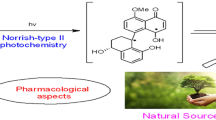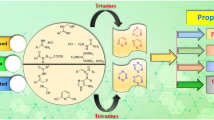Abstract
Synthesis of phenazine derivatives from the reaction of 2-naphthols with 1, 2-diamino benzenes in presence of K2S2O8 in AcOH and water, through the intermediate formation of 1, 2-naphthoquinones from self-coupling of 2-naphthol and then followed by condensation of 1, 2-diamino benzenes in one pot. The present reaction was compatible with various substituted 2-naphthols as well as substituted 1, 2-diamino benzenes to obtain a variety of substituted phenazine derivatives in good to excellent yields. The reaction was highly regio-selective in the case of unsymmetrical substituted 1, 2-diamino benzenes for providing single regio isomeric phenazine compounds. Reaction conditions were also mild and metal-free and also used green solvents such as AcOH and water. Phenazine derivatives are an important class of heterocycles and occur both in natural and synthetic compounds which shows many biological activities and also present in many important dyestuffs. In meantime, we have also shown our interest in antibacterial, anti-inflammatory activities and molecular docking studies. It is important to note that the phenazine derivatives showed excellent anti-bacterial and anti-inflammatory activities.
Graphic abstract







Similar content being viewed by others
References
Mavrodi D V, Bonsall R F, Delaney S M, Soule M J, Phillips G and Thomashow L S 2001 Functional analysis of genes for biosynthesis of pyocyanin and phenazine-1-carboxamide from Pseudomonas aeruginosa PAO1 J. Bact. 183 6454
Handelsman J and Stabb E V 1996 Biocontrol of soilborne plant pathogens The Plant Cell 8 1855
Gomez J A, Lage M R, Carneiro J W, Resende J A and Vargas M D 2013 Tautomerism in quinoxalines derived from the 1, 4-naphthoquinone nucleus: acid mediated synthesis, X-ray molecular structure of 5-chlorobenzo [f] quinoxalin-6-ol and density functional theory calculations J. Brazil. Chem. Soc. 24 219
Zendah I, Riaz N, Nasr H, Frauendorf H, Schüffler A, Raies A and Laatsch H 2012 Chromophenazines from the terrestrial Streptomyces sp. Ank 315 J. Nat. Prod. 75 2
Giddens S R, Feng Y and Mahanty H K 2002 Characterization of a novel phenazine antibiotic gene cluster in Erwinia herbicola Eh1087 Mol. Microbiol. 45 769
Giddens S R and Bean D C 2007 Investigations into the in vitro antimicrobial activity and mode of action of the phenazine antibiotic D-alanylgriseoluteic acid Int. J. Antimicrob. Agent. 29 93
Ingram J M and Blackwood A C 1970 Microbial production of phenazines Adv. Appl. Microbiol. 13 267
Turner J M and Messenger A J 1986 Occurrence, biochemistry and physiology of phenazine pigment production Adv. Microb. Physiol. 27 211
Maul C, Sattler I, Zerlin M, Hinze C, Koch C, Maier A, et al. 1999 Biomolecular-chemical Screening: A Novel Screening Approach for the Discovery of Biologically Active Secondary Metabolites J. Antibiot. 52 1124
Chin-A-Woeng T F C, Bloemberg G V, van der Bij A J, van der Drift K, Schripsema J, Kroon B, Scheffer R J, Keel C, Bakker P, Tichy H V, de Bruijn F J, Thomas-Oates J E and Lugtenberg B J J 1998 Biocontrol by phenazine-1-carboxamide-producing Pseudomonas chlororaphis PCL1391 of tomato root rot caused by Fusarium oxysporum f.sp. radicis-lycopersici Mol. Plant-Microb. Interact. 11 1069
Kim W G, Ryoo I J, Yun B S, Shin-ya K, Seto H and Yoo I D 1999 Phenazostatin C, a new diphenazine with neuronal cell protecting activity from Streptomyces sp J. Antibiot. 52 758
Yun B S, Ryoo I J, Kim W G, Kim J P, Koshino H, Scto H and Yoo I D 1996 Structures of phenazostatins A and B, neuronal cell protecting substances of microbial origin Tetrahedron Lett. 37 8529
Katoh A, Yoshida T and Ohkanda J 2000 Synthesis of quinoxaline derivatives bearing the styryl and phenylethynyl groups and application to a fluorescence derivatization reagent Heterocycles 52 911
Probably A and Aue W 1901 On the effect of nitrobenzene on aniline in the presence of alkali Rep. German Chem. Soc. 34 2442
Bamberger E and Ham W 1911 About the behavior of some para substituted nitrosobenzenes against conc.Sulfuric acid Justus Liebig’s Annal. Chem. 382 82
Haddadin M J and Issidorides C H 1965 Enamines with isobenzofuroxan: a novel synthesis of quinoxaline-di-n-oxides Tetrahedron Lett. 6 3253
Gamage S A, Spicer J A, Rewcastle G W, Milton J, Sohal S, Dangerfield W, et al. 2002 Structure-activity relationships for pyrido-, imidazo-, pyrazolo-, pyrazino-, and pyrrolophenazinecarboxamides as topoisomerase-targeted anticancer agents J. Med. Chem. 45 740
Hussain H, Specht S, Sarite S R, Saeftel M, Hoerauf A, Schulz B and Krohn K 2011 A new class of phenazines with activity against a chloroquine resistant Plasmodium falciparum strain and antimicrobial activity J. Med. Chem. 54 4913
Guo J, Xu Y W, Li K, Xiao L M, Chen S, Wu K, et al. 2017 Regio- and enantioselective photodimerization within the confined space of a homochiral ruthenium/palladium heterometallic coordination cage Angew. Chem. 129 3910
More N Y and Jeganmohan M 2017 Solvent-controlled selective synthesis of biphenols and quinones via oxidative coupling of phenols Chem. Commun. 53 9616
Wu R Y 1984 Studies on the Streptomyces SC4. II Taxonomic and biological characteristics of Streptomyces strain SC4 Bot. Bull. Acad. Sin. 25 111
Winter C A, Risley E A and Nuss G W 1962 Carrageenin-induced edema in hind paw of the rat as an assay for anti inflammatory drugs Proc Soc. Experim. Biol. Med. 111 544
Ramakrishna U V, Shyam P, Sinha S N and Vakdevi V 2016 Drug-Repositioning of the Gallate group from EGCG for the Repurposing Eur. J. Pharm. Med. Res. 3 253
Acknowledgements
Gajula Raju thanks UGC for providing BSR-SRF fellowship and BSN thanks DST-Purse for providing financial assistance to carry out research work and is also grateful to the Department of Chemistry, Osmania University Hyderabad, India for providing research facilities.
Author information
Authors and Affiliations
Corresponding author
Supplementary Information
Below is the link to the electronic supplementary material.
Rights and permissions
About this article
Cite this article
Gajula, R., Guguloth, V. & Battu, S. One-pot synthesis of phenazines from 2-naphthols with 1, 2-diamines and its biological importance and binding studies. J Chem Sci 133, 49 (2021). https://doi.org/10.1007/s12039-021-01907-4
Received:
Revised:
Accepted:
Published:
DOI: https://doi.org/10.1007/s12039-021-01907-4




